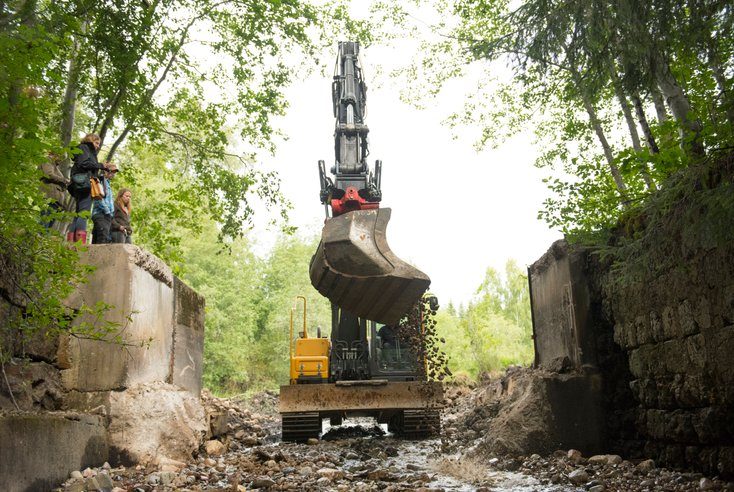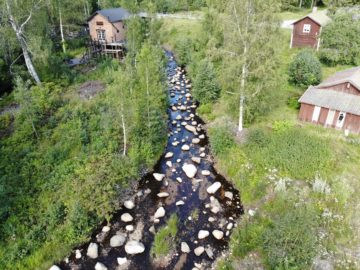By restoring the degraded river Lankälven, the Rewilding Lankälven project is also looking to stimulate and support activities based on local nature and culture.

Free flowing rivers
Free-flowing rivers with healthy fish populations offer a wide range of benefits to both wild nature and people, helping to support biodiverse ecosystems and thriving nature-based economies. This is why Rewilding Europe is working to restore rivers and fish migration in a number of its rewilding areas, and is a partner in the Dam Removal Europe coalition.
Rewilding Europe also supports European initiatives with similar restoration objectives. The Rewilding Lankälven project, which is working to rewild the River Lankälven in the centre of Sweden, has just joined the European Rewilding Network (ERN). The project becomes the fifth Sweden-based ERN member (including the Swedish Lapland rewilding area), demonstrating how rewilding efforts are scaling up and becoming more connected in the country.
“Our goal is to make the Lankälven wild again, with a focus on restoring the river’s brown trout and freshwater pearl mussel populations,” explains project assistant Alexander Baker. “We’re really excited to join the network because it will allow us to exchange information and knowledge with other network members involved in similar work.”
Multiple impacts
The River Lankälven is a small river located in Sweden’s Bergslagen District, a major ore-producing region around 200 kilometres west of Stockholm. The area’s mining and forestry industries have degraded much of the environment, and have impacted local rivers, including the Lankälven, in many ways.
“Waterways have been straightened and dammed, sand and gravel beds have been removed or covered up by particulate matter, water columns have been polluted with sediment, and riverbeds have been overexposed to sunlight as a result of clearcutting right to the edge of the water. Even though many of the surrounding forests have been well kept by private landowners, the River Lankälven is not in good condition.”
The culmination of these impacts has seen the brown trout population of the River Lankälven severely diminished, while the river’s freshwater pearl mussel population has completely disappeared. A small dam on the River Lankälven, first constructed in 1683 and rebuilt in the 1970s, has long prevented trout from moving upstream beyond the village of Södra Hyttan.
Recovering nature

The Rewilding Lankälven project kicked off in 2017 with the removal of the dam. Since then gravel beds have been added as spawning habitat for trout, while rocks and small boulders have also been returned to create habitat where for trout can thrive (trout eat a host of aquatic and terrestrial insects, other fish, crustaceans, leeches and worms).
The eventual aim is to replant a population of freshwater pearl mussels in the Lankälven. But before this can happen the ecosystem has to rebalance itself after the restoration efforts, and the river’s trout population has to start swimming upstream (the mussels depend on trout for part of their lifecycle).
“There is a dying mussel population in a stream on the other side of Lake Grängen (around five kilometres to the southwest),” explains Baker. “These can be relocated, but we have to be certain that the Lankälven environment is stable and safe for them first. We will continue to restore the river further upstream and remove a culvert that is also preventing trout passage.”
A restored River Lankälven will also help to connect the two biggest nature reserves in the region (Kindla and Nittälvsdalen), facilitating the movement and exchange of species through the creation of a blue-green corridor.
The people perspective
To complement rewilding efforts, the Rewilding Lankälven project is also developing a new visitor centre in Södra Hyttan to introduce people to the area’s wild nature. The Bergslagens Visitor Center, which will open fully in 2021, will become a hub for natural and cultural experiences, and is already hosting workshops, volunteering camps and presentations.
The idea is to use locally produced art and other expressions of culture to make the nature of Lankälven, and scientific research on it, more accessible. In the longer term the plan is to use the recovery of nature in the Lankälven area as a way to develop a local nature-based economy. One partner in the visitor centre is the local fishing conservation organisation.
“Together with this organisation we are looking at the possibility of catch and release fishing, and ways that local guides could earn income from fishing tourism and nature tourism in general,” explains Baker.
ERN 2.0
Today rewilding is gaining momentum as a progressive and effective approach to conservation in Europe. Underpinning this trend, the burgeoning ERN continues to foster collaboration and amplify results.
Founded by Rewilding Europe in 2013, the aim of the ERN is to enhance the efforts of each member by facilitating the exchange of skills, insight and experience. Members meet regularly, usually via webinar, while nature-based businesses can also apply to Rewilding Europe Capital, Rewilding Europe’s enterprise loan facility.
The criteria for ERN membership have recently been revised, as the network shifts its focus from expansion to support for practical, result-oriented rewilding. Rewilding Europe extends a warm welcome to all European rewilding initiatives and encourages them to apply for ERN membership.
Want to know / experience more?
- European Rewilding Network
- Read more about the revised ERN admission criteria
- Swedish Lapland rewilding area
